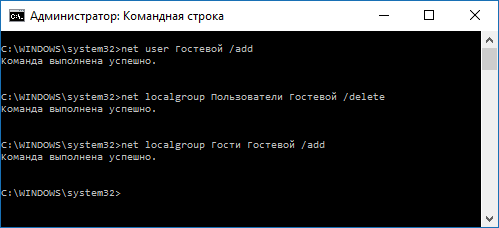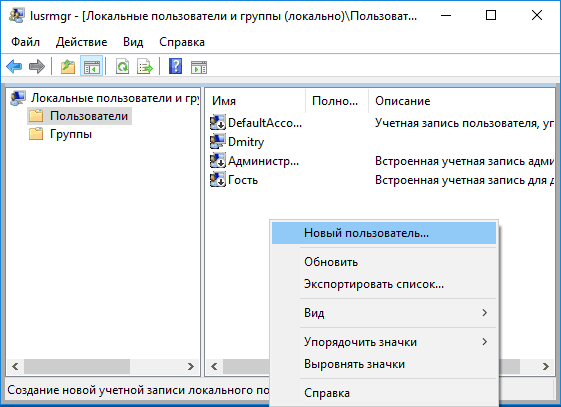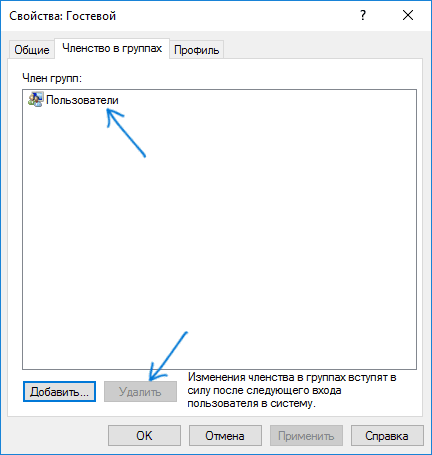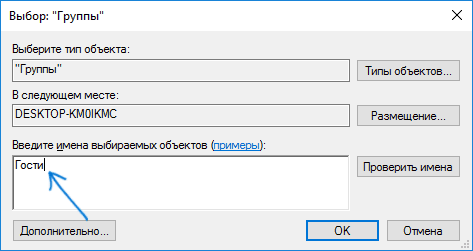Все способы:
- Особенности встроенного «Гостя» в Windows 10
- Способ 1: Локальные пользователи и группы
- Способ 2: Консоль «PowerShell»
- Вопросы и ответы: 0
Особенности встроенного «Гостя» в Windows 10
В Windows 10 уже имеется встроенная учетная запись «Гость», которую можно активировать из «Редактора локальных групповых политик», «Редактора реестра», оснастки управления пользователями и группами или «Командной строки», однако она не будет работать так, как в предыдущих версиях системы. Начиная со сборки Windows 10 10159, возможности встроенной учетной записи «Гость» были ограничены.
Во-первых, активированная встроенная гостевая учетная запись не будет отображаться на экране входа в систему, во-вторых, при попытке входа в нее из меню переключения между пользователями станет открываться экран входа в систему. Чтобы создать в Windows 10 гостя, сначала придется создать обычного пользователя, удалить его из группы, в которой он в данный момент находится, и переместить его в группу «Гости», которая по-прежнему доступна и нормально функционирует в Windows 10.
Способ 1: Локальные пользователи и группы
Для создания гостя в Windows 10 удобнее всего использовать встроенную оснастку управления локальными пользователями и группами.
- Откройте оснастку «Локальные пользователи и группы», для чего выполните в вызванном нажатием клавиш Win + R окошке команду
lusrmgr.msc. - Выделив мышкой папку «Пользователи», кликните по пустой области правой колонки правой кнопкой мыши и выберите из меню опцию «Новый пользователь».
- В открывшемся окне дайте создаваемому пользователю имя и описание (необязательно) и нажмите «Создать».
- Откройте «Свойства» только что созданного пользователя из его контекстного меню.
- В окне «Свойств» переключитесь на вкладку «Членство в группах», выделите текущую группу(ы) и нажмите «Удалить». Затем тут же нажмите кнопку «Добавить».
- Откроется диалоговое окошко выбора групп. В поле ввода имен выбираемых объектов введите название группы «Гости» и сохраните настройки нажатием «ОК».
- Сохраните настройки.

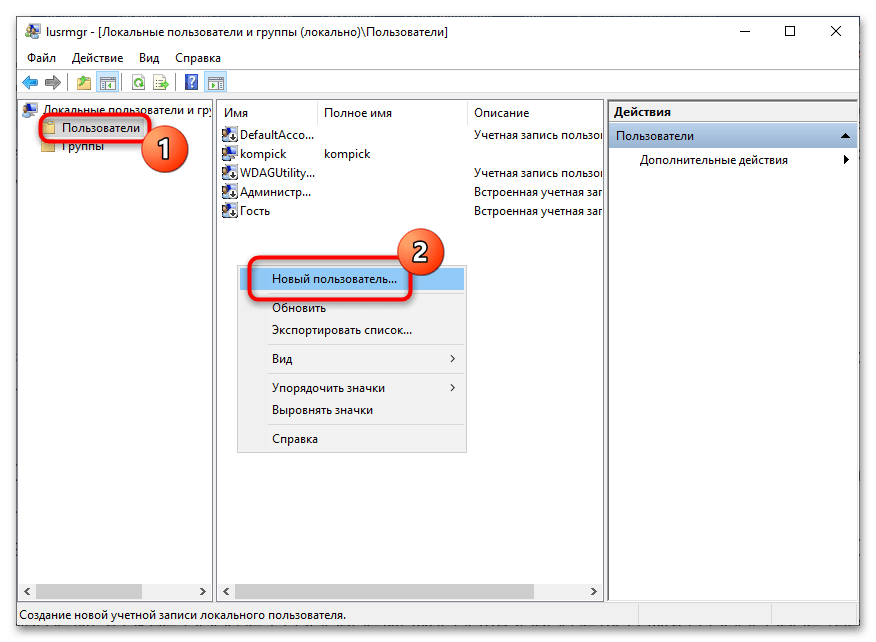

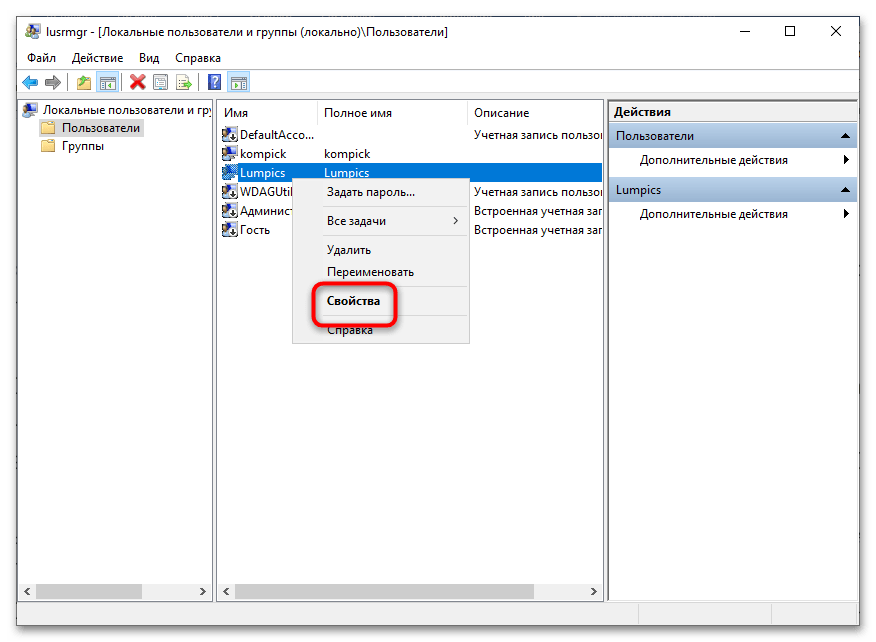
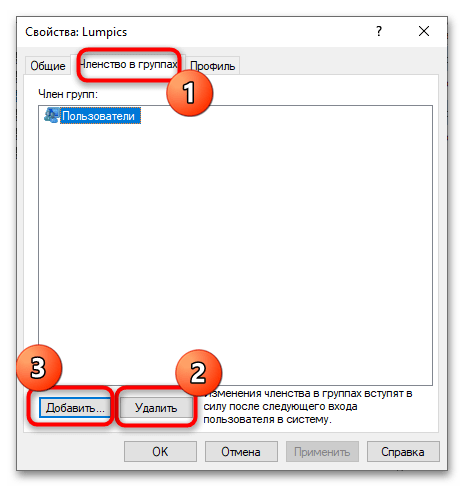
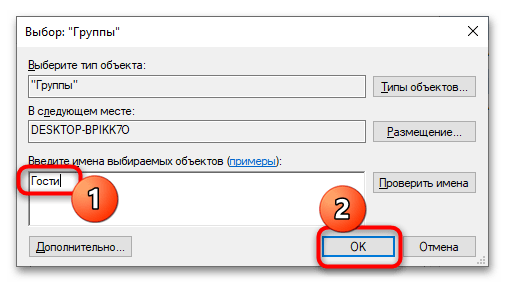
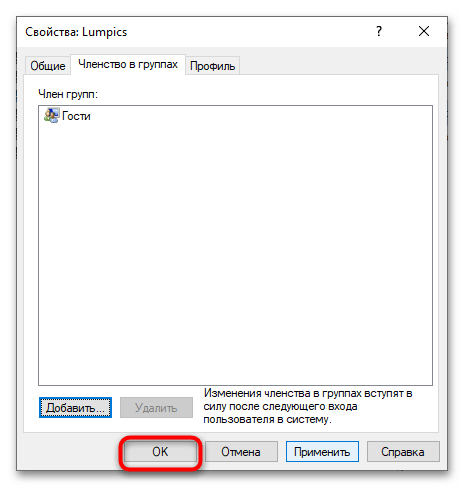
Готово, выйдите из своей учетной записи и войдите в учетную запись гостя, чтобы операционная система смогла создать для него необходимые файлы.
Способ 2: Консоль «PowerShell»
Альтернативным вариантом создания гостевой учетной записи в Windows 10 является использование консольной утилиты «Net».
- Откройте от имени администратора «Командную строку» или «PowerShell». Первую консоль можно открыть из системного поиска, вторую – из контекстного меню кнопки «Пуск».
- Выполните команду создания нового пользователя
net user NameGuest /add,где NameGuest – произвольное имя гостевой учетной записи. - Если нужно защитить учетную запись паролем, выполните команду
net user NameGuest pass, заменив pass реальным паролем. - Удалите только что созданного пользователя из группы «Пользователи» и поместите его в гостевую группу, для чего тут же в консоли выполните команды
net localgroup Пользователи NameGuest /deleteиnet localgroup Гости NameGuest /add.
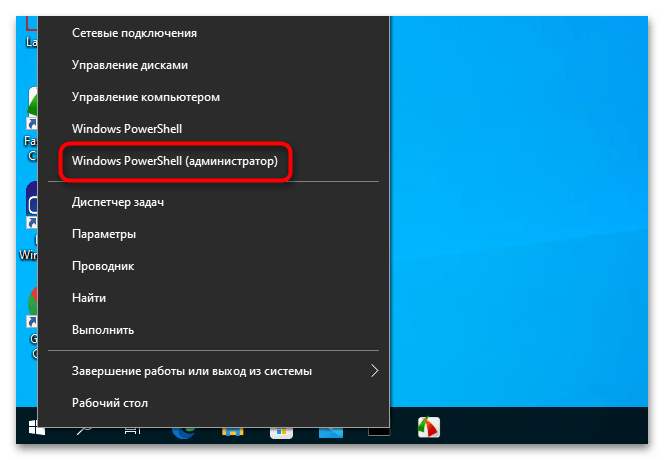
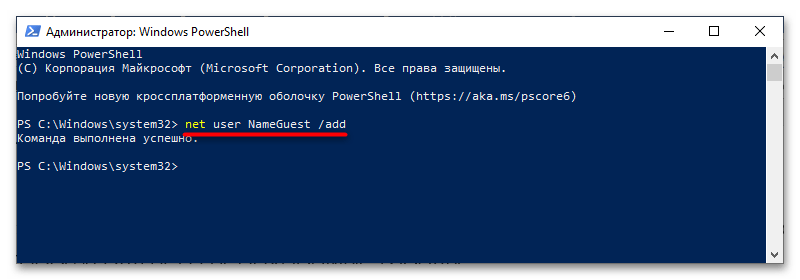

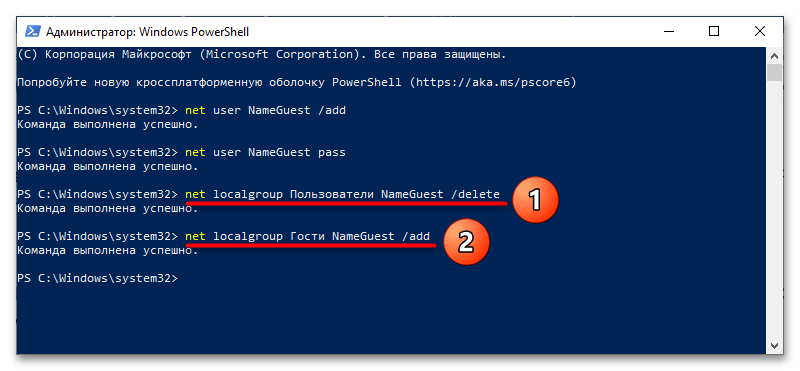
Учетная запись будет зарегистрирована в системе и перемещена в группу гостей, но чтобы создать для нее необходимые файлы и установить поставляемое с Windows программное обеспечение, нужно в нее войти с экрана входа в систему.
Наша группа в TelegramПолезные советы и помощь
Учетная запись «Гость» в Windows позволяет предоставить временный доступ к компьютеру пользователям без возможности для них устанавливать и удалять программы, изменять настройки, устанавливать оборудование, а также открывать приложения из Магазина Windows 10. Также при гостевом доступе пользователь не сможет просмотреть файлы и папки, находящиеся в пользовательских папках (Документы, Изображения, Музыка, Загрузки, Рабочий стол) других пользователей или удалить файлы из системных папок Windows и папок Program Files.
В этой инструкции пошагово описаны два простых способа включить учетную запись Гость в Windows 10 с учетом того факта, что с недавних пор встроенный пользователь «Гость» в Windows 10 перестал работать (начиная со сборки 10159).
Примечание: для ограничения пользователя единственным приложением используйте Режим киоска Windows 10.
Включение пользователя Гость Windows 10 с помощью командной строки
Как было отмечено выше, неактивная учетная запись «Гость» присутствует в Windows 10, но не работает так, как это было в предыдущих версиях системы.
Его можно включить несколькими способами, такими как gpedit.msc, «Локальные пользователи и группы» или команда net user Гость /active:yes — при этом он не появится на экране входа в систему, но будет присутствовать в переключении пользователей меню пуск других пользователей (без возможности входа под Гостем, при попытке сделать это вы вернетесь на экран входа в систему).

Тем не менее в Windows 10 сохранилась локальная группа «Гости» и она работоспособна, таким образом, чтобы включить учетную запись с гостевым доступом (правда, назвать её «Гость» не получится, так как это имя занято за упомянутой встроенной учетной записью), потребуется создать нового пользователя и добавить его в группу Гости.
Самый простой способ сделать это — использовать командную строку. Шаги по включению записи Гость будут выглядеть следующим образом:
- Запустите командную строку от имени администратора (см. Как запустить командную строку от имени Администратора) и по порядку используйте следующие команды, нажимая Enter после каждой из них.
- net user Имя_пользователя /add (здесь и далее Имя_пользователя — любое, кроме «Гость», которое вы будете использовать для гостевого доступа, у меня на скриншоте — «Гостевой»).
- net localgroup Пользователи Имя_пользователя /delete (удаляем вновь созданную учетную запись из локальной группы «Пользователи». Если у вас изначально англоязычная версия Windows 10, то вместо Пользователи пишем Users).
- net localgroup Гости Имя_пользователя /add (добавляем пользователя в группу «Гости». Для англоязычной версии пишем Guests).
Готово, на этом учетная запись Гость (а точнее — созданная вами учетная запись с правами Гостя) будет создана, и вы сможете войти в Windows 10 под ней (при первом входе в систему некоторое время будут настраиваться параметры пользователя).
Как добавить учетную запись Гостя в «Локальные пользователи и группы»
Еще один способ создать пользователя и включить для него гостевой доступ, подходящий только для версий Windows 10 Профессиональная и Корпоративная — использование инструмента «Локальные пользователи и группы».
- Нажмите клавиши Win+R на клавиатуре, введите lusrmgr.msc для того, чтобы открыть «Локальные пользователи и группы».
- Выберите папку «Пользователи», нажмите правой кнопкой мышки в пустом месте списка пользователей и выберите пункт меню «Новый пользователь» (или используйте аналогичный пункт в панели «Дополнительные действия» справа).
- Укажите имя для пользователя с гостевым доступом (но не «Гость»), остальные поля заполнять не обязательно, нажмите кнопку «Создать», а затем — «Закрыть».
- В списке пользователей дважды кликните по вновь созданному пользователю и в открывшемся окне выберите вкладку «Членство в группах».
- Выберите в списке групп «Пользователи» и нажмите «Удалить».
- Нажмите кнопку «Добавить», а затем в поле «Выберите имена выбираемых объектов» введите Гости (или Guests для англоязычных версий Windows 10). Нажмите «Ок».
На этом необходимые шаги закончены — можно закрыть «Локальные пользователи и группы» и войти под учетной записью Гостя. При первом входе некоторое время займет настройка параметров для нового пользователя.
Дополнительная информация

После входа в учетную запись Гостя вы можете заметить два нюанса:
- То и дело появляющееся сообщение о том, что OneDrive невозможно использовать с учетной записью Гостя. Решение — убрать OneDrive из автозагрузки для этого пользователя: правый клик по значку «облака» в панели задач — параметры — вкладка «параметры», убрать отметку автоматического запуска при входе в Windows. Также может пригодиться: Как отключить или удалить OneDrive в Windows 10.
- Плитки в меню пуск будут выглядеть как «стрелки вниз», иногда сменяющиеся надписью: «Скоро выйдет отличное приложение». Связано это с невозможностью устанавливать приложения из магазина «под Гостем». Решение: правый клик по каждой такой плитке — открепить от начального экрана. В результате меню пуск может показаться слишком пустым, но вы можете исправить это, изменив его размер (края меню пуск позволяют изменять его размер).
На этом всё, надеюсь, информация была достаточной. Если же остались какие-то дополнительные вопросы — можно задать их ниже в комментариях, буду стараться отвечать. Также, в плане ограничения прав пользователей может оказаться полезной статья Родительский контроль Windows 10.

Microsoft has added plenty of new features to Windows in recent years, but some functionality has been removed in that time.
That includes the ability to create a “Guest” account, separate from any of the main user accounts. Previously, it offered an easy way to share your computer with someone, without risking any of your settings or files being affected.
Not only is the feature unavailable in
Windows 11, it’s also been removed from Windows 10 . This is presumably for security reasons, but the risk when giving access to friends or family is very low.
Fortunately, a workaround means it’s still possible to create an account with these characteristics. It won’t be officially known as a “Guest” account, but it performs in much the same way.
How to create a guest account on Windows 11
There are several ways to do this, but the easiest method is via Settings. The first step involves creating a new local account:
- Open Settings and choose ‘Accounts’ from the left pane
- From the menu that appears, select ‘Family & other users’
- Under ‘Other users’, click the button labeled ‘Add account’
- After a few seconds, you’ll be prompted to enter an email address or phone number. Instead, click ‘I don’t have the person’s sign-in information’ just below where you’d type
- Now, you’ll see three options on the ‘Create account screen’. Choose the one which says ‘Add a user without a Microsoft account’
- Next, provide a name for the account you’d like to create. ‘Visitor’ makes sense, as you still can’t use the ‘Guest’ name here
- Enter the chosen password twice, followed by answers to three security questions
- Click next to complete this process
The newly created account will now be listed under ‘Other users’. To start using it, simply sign out of your current account and sign in to the new one. You’ll need to log in to many apps and services again, but most functions are still accessible.
To make things more restrictive, you’ll then need to add that account to the “Guest” user group:
- Open the ‘Computer Management’ window by searching for it via the taskbar
- From the left pane, choose System Tools > Local Users and Groups > Users
- Locate the newly created account, right-click it and choose ‘Properties’
- From the ‘Member Of’ tab, choose ‘Add’, then ‘Advanced’
- Click ‘Find Now’, then scroll down until you find ‘Guests’
- Click it, then hit ‘OK’ twice to confirm
- You’ll now see ‘Guests’ added to the list. Select ‘Users’ and remove it
- Click ‘Apply’, followed by ‘OK’ to confirm changes
If you’re not seeing the ‘Local Users and Groups’ option, there’s a simple solution – just
download ‘lusrmgr’ from GitHub. It opens in a separate window, but the process is roughly the same:
- Click ‘Users’ from the left pane
- Double-click the account and select the ‘Group membership tab’
- Click ‘Add membership…’, then highlight ‘Guests’ and choose ‘Select’
- This will now be added to the list. Next, highlight ‘Users’ and remove it
- Click ‘OK’ to save changes, then log out and log back in again to apply changes
Is creating a guest account on Windows 10 different?
Very slightly. Windows 10 users can follow all the same steps as above, aside from finding the option to add a new user in Settings:
- Head to Settings > Accounts > Other users
- Under ‘Other users’, click ‘Add someone else to this PC’
That’s the only difference. Now, scroll up to the Windows 11 section and start from step 4 of the first section.
There’s no limit on the number of guest accounts you can create. But if you want someone to be able to change Settings or remove files (for example), just follow the steps on creating the local account. Both methods are an effective ways of providing limited access to your personal device.
Related articles for further reading
- How to log in to your Windows PC without the password
- How to remove the password from a Microsoft account
- How to get Windows 11 now
Anyron is Mobile Editor at Tech Advisor, where he’s been a mainstay of the editorial team since 2019. In his current role, Anyron is responsible for all smartphone, tablet and mobile network coverage on the site. A BA Journalism graduate, he has experience with a wide range of consumer tech products and services, including smartphones, tablets, foldables, wearables and more.
Windows’ guest account lets other people use your computer without being able to change PC settings, install apps or access your private files. That comes in handy when you have to share your computer temporarily. In Windows 10, you can no longer easily turn on the guest account from the Control Panel. Here’s a workaround to enabling a guest account — that actually works.
Across the web, you’ll find articles that tell you how to enable the «hidden» guest account in Windows 10, using the Command Prompt or the group policy editor in Windows. While these methods do make it look like the guest account is enabled, they don’t actually work. When you try to switch to the guest account, you’ll be instead forced to log into your current account.
- Show the Full Folder Path in File Explorer on Windows 10
- How to get help in Windows 10
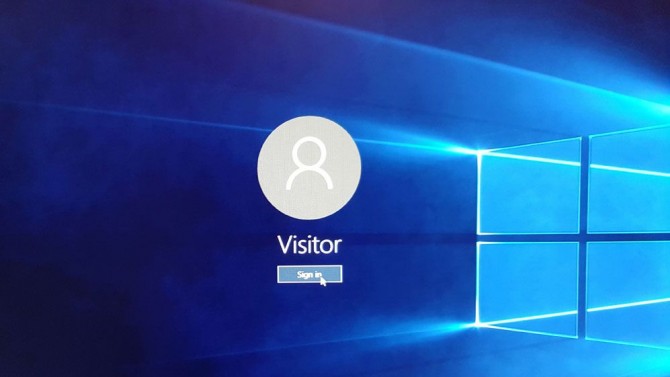
There is a method, however, that I’ve tried that does work, adapted from a tip offered by Super User member The Professional: Create a new user account and assign it to the guests group. This will make that account act the same way the built-in guest account should: The user will be able to use your computer without accessing settings or installing apps. Since «Guest» is a reserved account name in Windows, we’ll use «Visitor.»
- Here’s how To Disable Taskbar on a Second Monitor in Windows 10
- This is how to Take a Scrolling Screenshot in Windows 10
- See how to Hide a Recovery Partition (or Any Disk) in Windows 10
- Click-clack: Here’s how to enable keyboard typing sounds in Windows 10
1. Right-click on the Windows button and select Command Prompt (Admin). This is the quickest way to open the Command Prompt as an administrator.
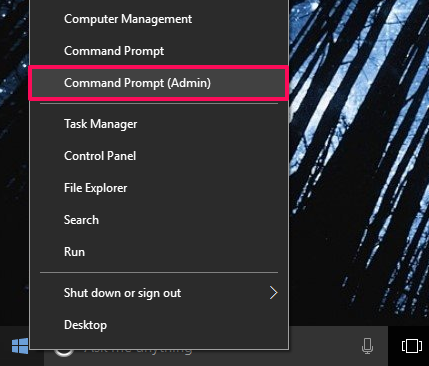
2. Click Yes when asked if you want to continue.
3. Type the following command and then click Enter:
net user Visitor /add /active:yes
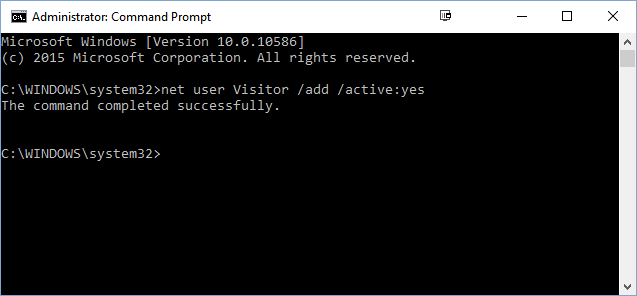
4. Press Enter twice when asked to set a password. This will create a blank password for the account.
Sign up to receive The Snapshot, a free special dispatch from Laptop Mag, in your inbox.
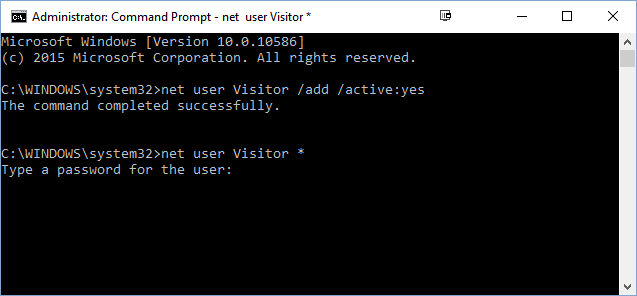
5. Type the following command and then hit Enter:
net localgroup users Visitor /delete
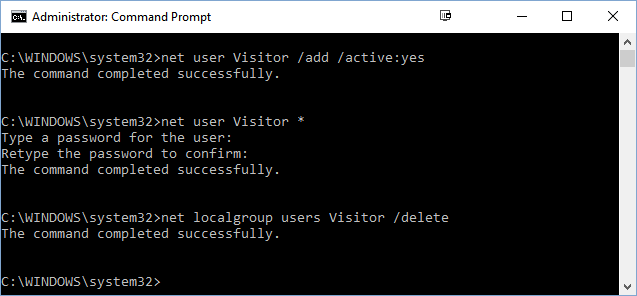
This removes the Visitor user from the default users group.
6. Type the following command and then hit Enter:
net localgroup guests Visitor /add

This adds the Visitor user to the guests group, which is more restricted than local users.
That’s all there is to it. You can now close the Command Prompt window.
How to Switch to the Guest Account
1. Click the Windows button.
2. Click on your username.
3. Click Visitor.
Alternatively, you can choose the Visitor account from the Windows login screen.
Now that you’ve learned how to create a guest account in Windows 10, why not figure out how to map a network drive so you can quickly access shared folders, or read our guide on how to access the BIOS on your Windows 10 system to change important settings.
Windows 10 Security and Networking
- Previous Tip
- Next Tip
- Use the Windows 10 Parental Controls
- Find Your MAC Address
- Turn Your Windows PC into a Wi-Fi Hotspot
- Password Protect a Folder
- Create a Guest Account in Windows 10
- Enable Windows Hello Fingerprint Login
- Set Up Windows Hello Facial Recognition
- How to Restrict Cortana’s Ever-Present Listening in Windows 10
- Automatically Lock Your PC with Dynamic Lock
- Blacklist Non-Windows Store Apps
- Find Saved Wi-Fi Passwords
- Set Up a Metered Internet Connection
- Use Find My Device
- Stream XBox One Games
- All Windows 10 Tips
- Map a Network Drive
- Create Limited User Accounts
- Set Time Limits for Kids
- Pin People to Your Taskbar
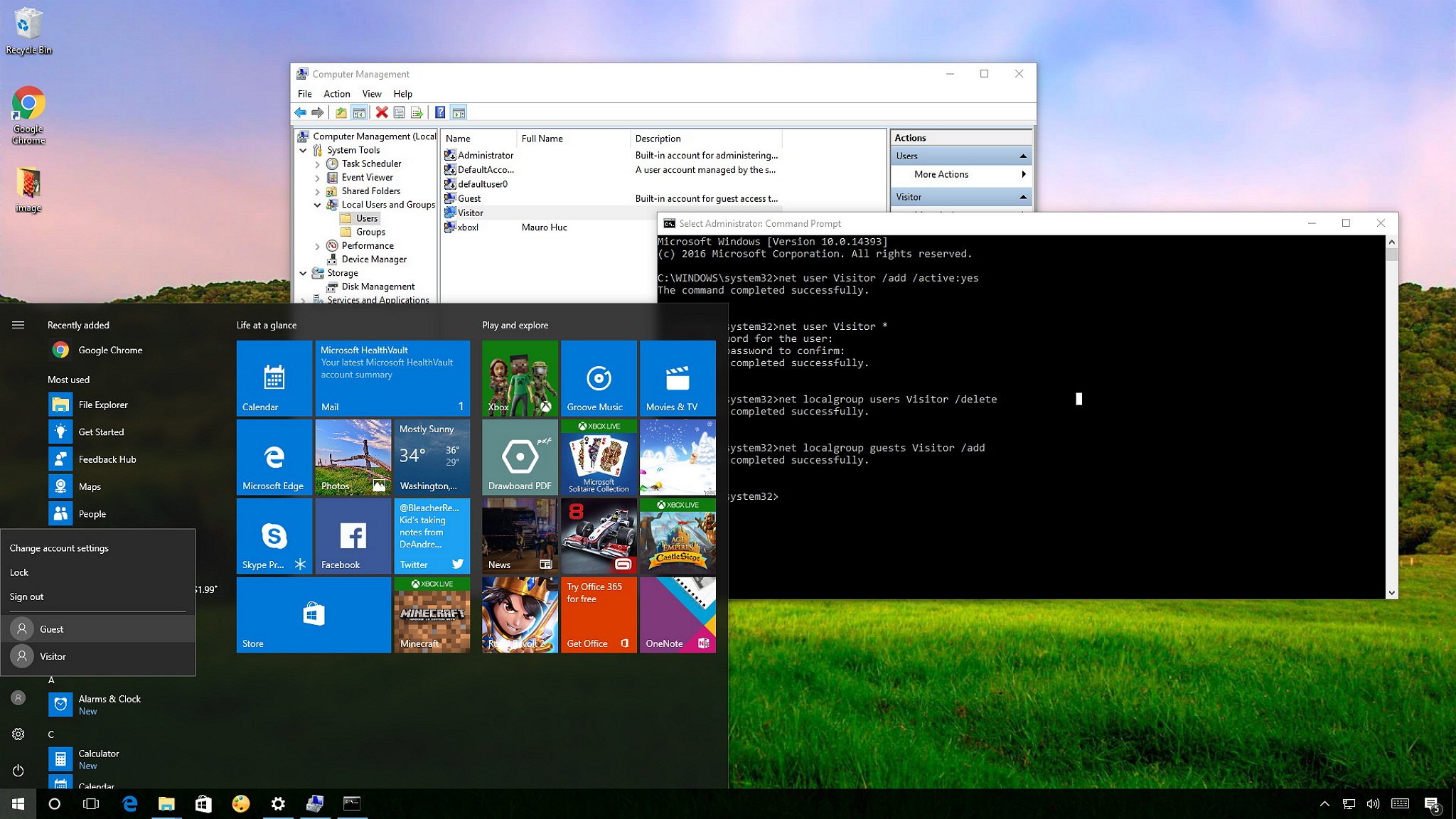
The concept of a guest account isn’t a bad one: a locked-down account that you can let other people use on your PC to access the internet, run apps, and not much more — all while keeping your files, settings, and everything else safe (in theory). But when Microsoft rolled out Windows 10, the Guest account disappeared.
You can enable it in a number of ways, but there’s no Guest account to use. In fact, if you manage to turn on the account, it won’t even show up on the sign-in screen.
However, the elements needed to create a guest account are still present in Windows 10, which makes it possible to create your very own restricted account to let guests use your PC. It just take a bit of user assembly.
In this Windows 10 guide, we’ll walk you through the steps to use Command Prompt to create a guest account on your PC.
How to create a guest account
- Open Start.
- Search for Command Prompt.
- Right-click the result and select Run as administrator.
- Type the following command to create a new account and press Enter:
net user Visitor /add /active:yesKeep in mind that we’re using the Visitor as the name of the account, because Guest is a reserved name on Windows 10 and you can’t use it. However, you’re free to name the account anything you like. Just keep it short, you don’t want to go crazy on the name. - Type the following command to create a password for the newly created account and press Enter:
net user Visitor * - You don’t need a password for this account, as such simply press Enter twice to create an empty password.
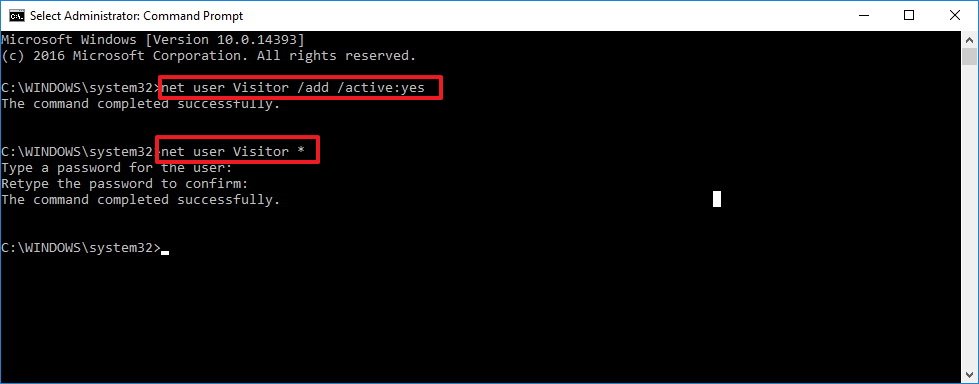
- Type the following command to remove the new user account from the default Users group and press Enter:
net localgroup users Visitor /delete - Type the following command to add the new user account to the Guests user group and press Enter:
net localgroup guests Visitor /add - Close Command Prompt to complete the task.
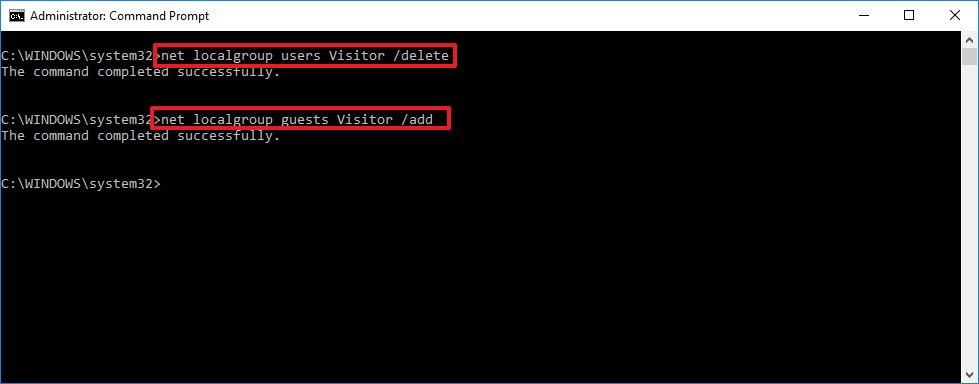
Using the steps mentioned above, you’re creating a traditional standard account, but removing it from the Users and adding it to the Guests user group is what gives the account all the same permissions you would find in the old Guest account.
Once you completed the steps, you only need to sign out of your current account, and in the Sign in screen, select the Visitor account and click the Sign in button — no password required.
Now with the new restricted account created, you can now safely share your computer with guests. They will be able to access the internet and use certain applications, but they won’t be able to change settings, install programs, and or access your files.
All the latest news, reviews, and guides for Windows and Xbox diehards.
If you no longer need the account, you can go to Settings > Accounts > Family & other people, select the Visitor account and click the Remove button to delete the account.
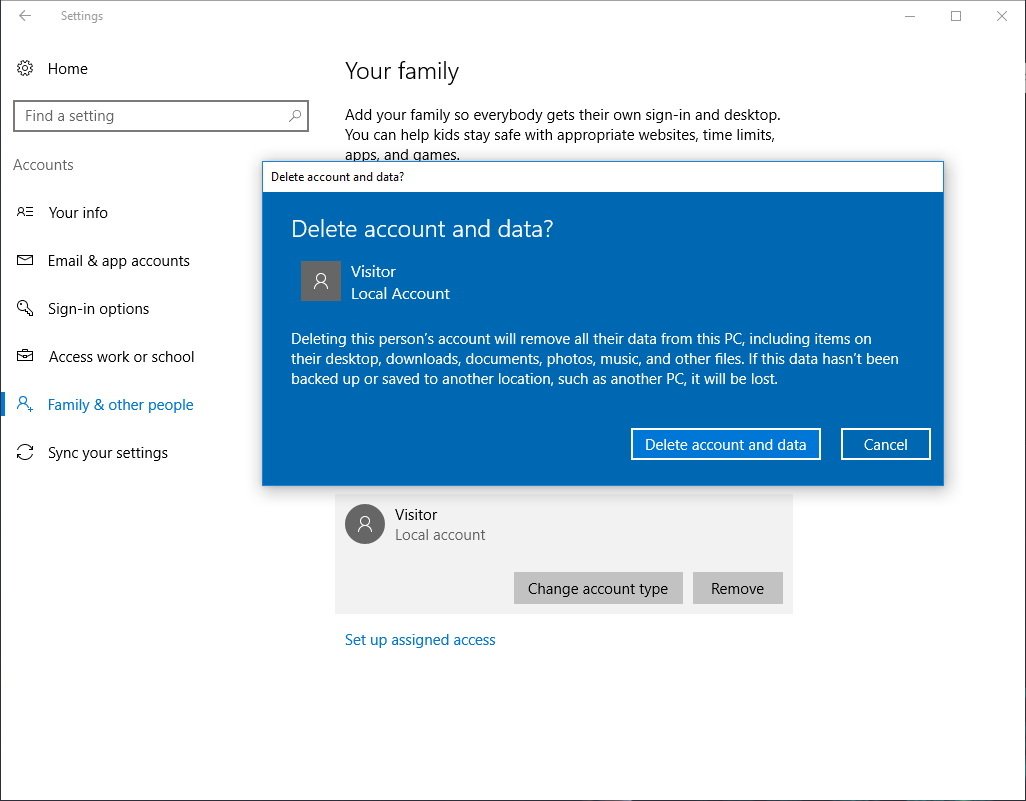
Do you think Microsoft should bring back the original Guest account to Windows 10? Tell us in the comments below.
More Windows 10 resources
For more help articles, coverage, and answers on Windows 10, you can visit the following resources:
- Windows 10 on Windows Central – All you need to know
- Windows 10 help, tips, and tricks
- Windows 10 forums on Windows Central
Mauro Huculak has been a Windows How-To Expert contributor for WindowsCentral.com for nearly a decade and has over 15 years of experience writing comprehensive guides. He also has an IT background and has achieved different professional certifications from Microsoft, Cisco, VMware, and CompTIA. He has been recognized as a Microsoft MVP for many years.

